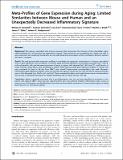| dc.contributor.author | Swindell, William R. | |
| dc.contributor.author | Johnston, Andrew | |
| dc.contributor.author | Sun, Liou | |
| dc.contributor.author | Xing, Xianying | |
| dc.contributor.author | Fisher, Gary J. | |
| dc.contributor.author | Bulyk, Martha Leonia | |
| dc.contributor.author | Elder, James T. | |
| dc.contributor.author | Gudjonsson, Johann E. | |
| dc.date.accessioned | 2012-09-10T18:05:33Z | |
| dc.date.issued | 2012 | |
| dc.identifier.citation | Swindell, William R., Andrew Johnston, Liou Sun, Xianying Xing, Gary J. Fisher, Martha L. Bulyk, James T. Elder, and Johann E. Gudjonsson. 2012. Meta-profiles of gene expression during aging: Limited similarities between mouse and human and an unexpectedly decreased inflammatory signature. PLoS ONE 7(3): e33204. | en_US |
| dc.identifier.issn | 1932-6203 | en_US |
| dc.identifier.uri | http://nrs.harvard.edu/urn-3:HUL.InstRepos:9527628 | |
| dc.description.abstract | Background: Skin aging is associated with intrinsic processes that compromise the structure of the extracellular matrix while promoting loss of functional and regenerative capacity. These processes are accompanied by a large-scale shift in gene expression, but underlying mechanisms are not understood and conservation of these mechanisms between humans and mice is uncertain. Results: We used genome-wide expression profiling to investigate the aging skin transcriptome. In humans, age-related shifts in gene expression were sex-specific. In females, aging increased expression of transcripts associated with T-cells, B-cells and dendritic cells, and decreased expression of genes in regions with elevated Zeb1, AP-2 and YY1 motif density. In males, however, these effects were contrasting or absent. When age-associated gene expression patterns in human skin were compared to those in tail skin from CB6F1 mice, overall human-mouse correspondence was weak. Moreover, inflammatory gene expression patterns were not induced with aging of mouse tail skin, and well-known aging biomarkers were in fact decreased (e.g., Clec7a, Lyz1 and Lyz2). These unexpected patterns and weak human-mouse correspondence may be due to decreased abundance of antigen presenting cells in mouse tail skin with age. Conclusions: Aging is generally associated with a pro-inflammatory state, but we have identified an exception to this pattern with aging of CB6F1 mouse tail skin. Aging therefore does not uniformly heighten inflammatory status across all mouse tissues. Furthermore, we identified both intercellular and intracellular mechanisms of transcriptome aging, including those that are sex- and species-specific. | en_US |
| dc.language.iso | en_US | en_US |
| dc.publisher | Public Library of Science | en_US |
| dc.relation.isversionof | doi:10.1371/journal.pone.0033204 | en_US |
| dc.relation.hasversion | http://www.ncbi.nlm.nih.gov/pmc/articles/PMC3296693/pdf/ | en_US |
| dash.license | LAA | |
| dc.subject | biology | en_US |
| dc.subject | anatomy and physiology | en_US |
| dc.subject | physiological processes | en_US |
| dc.subject | computational biology | en_US |
| dc.subject | genomics | en_US |
| dc.subject | model organisms | en_US |
| dc.subject | animal models | en_US |
| dc.subject | medicine | en_US |
| dc.subject | dermatology | en_US |
| dc.title | Meta-Profiles of Gene Expression during Aging: Limited Similarities between Mouse and Human and an Unexpectedly Decreased Inflammatory Signature | en_US |
| dc.type | Journal Article | en_US |
| dc.description.version | Version of Record | en_US |
| dc.relation.journal | PLoS ONE | en_US |
| dash.depositing.author | Bulyk, Martha Leonia | |
| dc.date.available | 2012-09-10T18:05:33Z | |
| dc.identifier.doi | 10.1371/journal.pone.0033204 | * |
| dash.contributor.affiliated | Bulyk, Martha | |


